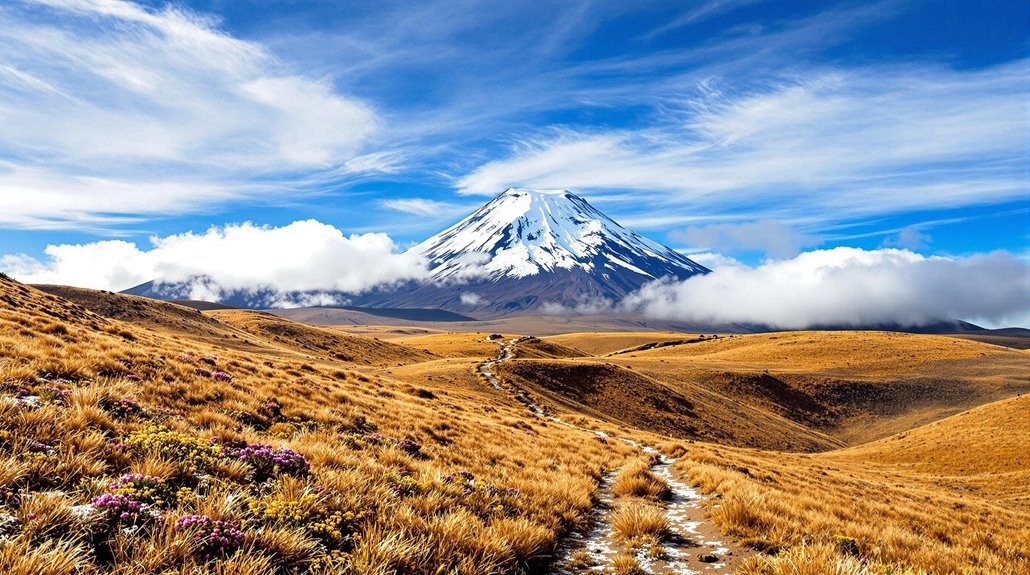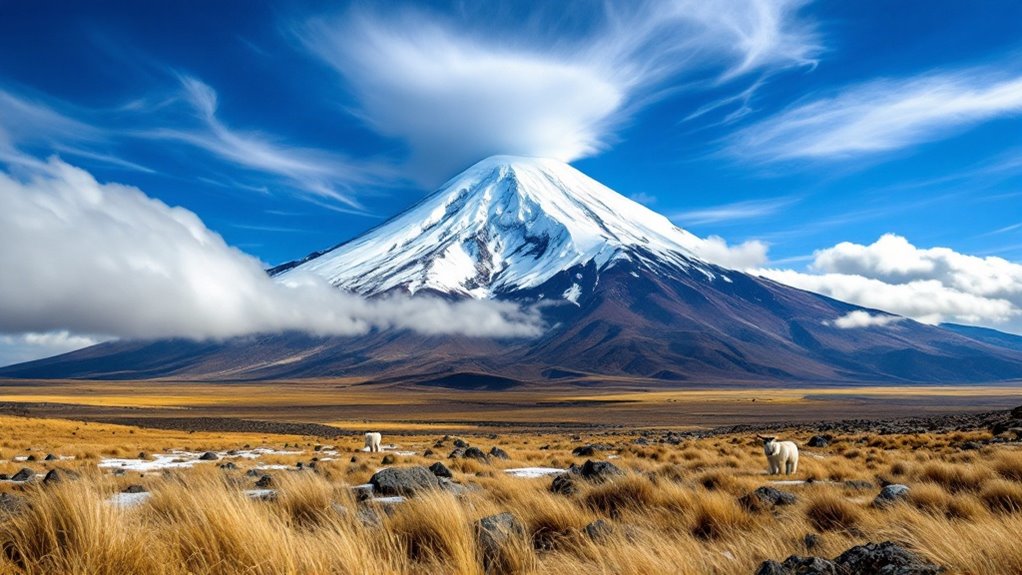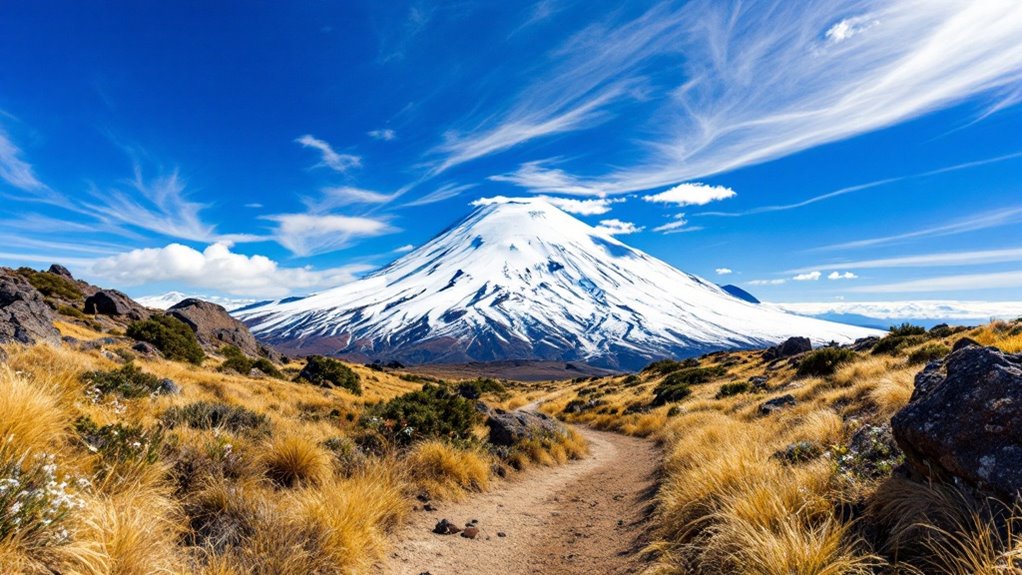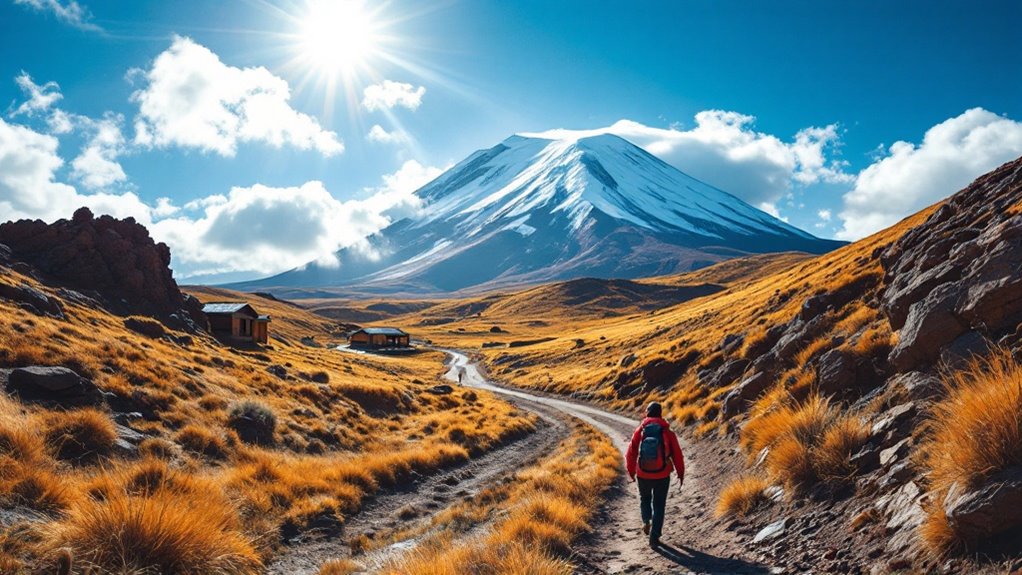Physical Address
304 North Cardinal St.
Dorchester Center, MA 02124
Physical Address
304 North Cardinal St.
Dorchester Center, MA 02124

Majestic Cotopaxi volcano defies logic with equatorial snow, beckoning adventurers to explore its otherworldly slopes in Ecuador's premier national park.
You will discover it hard to believe there's snow at the equator until you stand at the base of Cotopaxi's towering peak. This iconic Ecuadorian volcano rises 19,347 feet above sea level, where tropical warmth gives way to perpetual ice. Whether you're a casual day hiker or an ambitious mountaineer, you'll need more than just your standard trail gear to explore this unique national park. Let's unpack what makes Cotopaxi a puzzling yet magnificent destination for adventurers on any budget.

Although Cotopaxi sits right on the equator, you won't find the tropical climate you might expect. The mountain's extreme elevation creates its own weather patterns, with temperatures dropping 5-6°C for every 1,000 meters you climb.
Despite its equatorial location, Cotopaxi defies expectations with alpine temperatures that plummet dramatically as altitude increases.
While the base area stays moderate at 14-15°C during the day, you'll encounter subzero conditions (-10°C) at the glaciated summit.
You'll experience distinct climate zones as you ascend through cloud forests and páramo grasslands to the glacier line at 5,000m. Despite its equatorial location, Cotopaxi receives substantial precipitation – about 1,832mm annually – with March being the wettest month. The mountain's unpredictable conditions mean that only half of climbers successfully reach the summit.
Don't let the latitude fool you; you'll need proper cold-weather gear year-round. The mountain's weather can change rapidly, so pack for both sun and storms, regardless of when you visit.
When tackling Cotopaxi's challenging terrain, you'll need both specialized gear and solid physical preparation to guarantee a safe, successful climb.
Start with layered clothing: a moisture-wicking base, insulated waterproof jacket, and sturdy trekking pants. Don't skimp on warm accessories – multiple gloves and a good hat are essential. At the Jose Rivas Refuge, you'll find dormitory-style accommodation for overnight preparation before your summit attempt.
For technical gear, you can rent most items in Quito, including crampons and ice axes. Essential safety gear includes a 40L+ backpack, bright headlamp, and emergency shelter. Pack a reliable GPS device with offline maps.
Your training should combine aerobic workouts, leg strength, and altitude preparation. Plan 4-5 weekly cardio sessions and regular loaded hikes.
Once there, follow a careful acclimatization strategy: spend 2-3 days at 3,000m and stay well-hydrated with 4-6L daily.

Depending on your hiking experience and fitness level, Cotopaxi National Park offers trails ranging from easy lakeside strolls to challenging glacier climbs.
For beginners, try the flat 2.6 km Laguna Limpiopungo Loop, where you'll spot migratory birds while walking at 3,850 m. At an elevation of 5,897 meters, Cotopaxi stands as Ecuador's second-highest peak, dominating the landscape around you.
If you're ready for a moderate challenge, take the Base Camp Route to José Rivas Refuge – it's a steep but manageable 7.24 km round-trip climb to 4,800 m.
Advanced hikers can tackle the highly-rated Cerro Rumiñahui Trail, an 11.4 km journey with stunning volcano views.
For the ultimate adventure, the Cotopaxi Summit Route demands technical skills and a guide – only 50% make it to the top.
You'll need crampons and ice axes, starting your climb at midnight for a sunrise summit.
Since Cotopaxi's diverse ecosystems span from glacial peaks to páramo grasslands, you'll discover an incredible array of wildlife and natural phenomena without spending a fortune.
Spot the majestic Andean Condor, with its 3m wingspan, soaring above the volcanic landscape, or glimpse the elusive spectacled bear in cloud forests. The characteristic dense grass vegetation provides essential cover and habitat for many of the park's species.
Watch in awe as the Andean Condor glides majestically overhead, while mysterious spectacled bears roam the misty forest below.
The best wildlife viewing won't cost you anything – just time and patience. Visit during November-March when warmer temperatures boost animal activity.
Head to Limpiopungo Lagoon at dawn to see Andean gulls and ducks against the volcano's reflection. Keep your eyes peeled for the world's largest hummingbird species and watch for white-tailed deer grazing in the páramo.
Stay on marked trails and consider joining an affordable guided tour to maximize your chances of spotting the park's shyer residents.

After spotting wildlife in the park's diverse ecosystems, you'll discover the need to plan your journey and lodging.
You can reach Cotopaxi National Park in just an hour from Quito by car, making it perfect for day trips or extended stays. For budget travelers, catch a bus from Quito's Quitumbe terminal to Latacunga for $2-3, then take a taxi to the park entrances for $15-20.
The park's strategic location puts you close to other must-see destinations: Quilotoa crater lake to the south, Baños to the east, and Quito to the north. The park's name comes from the ancient Quechua and Aymara languages, reflecting its rich cultural heritage.
Situated in Ecuador's Andes Mountains, the park spans three provinces and climbs to an impressive 5,897 meters at Cotopaxi's summit.
You'll discover yourself exploring 333.9 square kilometers of stunning mountain terrain.
Although Cotopaxi's weather can change rapidly throughout the day, you'll discover the most stable conditions from June through September, when rainfall drops to 59-133mm monthly and visibility peaks.
During this prime hiking season, you can expect daytime temperatures around 14-15°C and clearer skies, especially in August when humidity dips to 69%. The mountain's double mountaineering boots are essential gear for navigating these conditions safely.
If you can't make the main season, consider the November-February window as your backup.
While you'll encounter slightly more rain (59-181mm monthly) and occasional afternoon storms, the warmer February temperatures reaching 20°C can make for pleasant hiking conditions.
Just avoid March through May when rainfall spikes to 239-261mm, and be prepared for dramatic temperature swings regardless of when you visit – summit temperatures can plummet to -20°C with wind chill.
You will discover Cotopaxi National Park offers an incredible mix of equatorial snow and tropical terrain that won't break your bank. Pack smart, train well, and time your visit during the drier months between June and September for the best experience. Whether you're tackling the summit or enjoying a day hike, there's a trail that fits your budget and skill level. Don't forget to book basic lodging ahead and use local transport to save money.